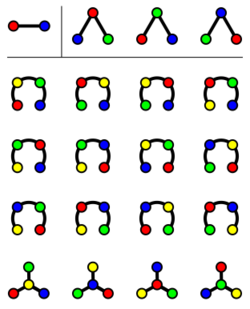Cayley's formula
In mathematics, Cayley's formula is a result in graph theory named after Arthur Cayley. It states that for every positive integer [math]\displaystyle{ n }[/math], the number of trees on [math]\displaystyle{ n }[/math] labeled vertices is [math]\displaystyle{ n^{n-2} }[/math].
The formula equivalently counts the number of spanning trees of a complete graph with labeled vertices (sequence A000272 in the OEIS).
Proof
Many proofs of Cayley's tree formula are known.[1] One classical proof of the formula uses Kirchhoff's matrix tree theorem, a formula for the number of spanning trees in an arbitrary graph involving the determinant of a matrix. Prüfer sequences yield a bijective proof of Cayley's formula. Another bijective proof, by André Joyal, finds a one-to-one transformation between n-node trees with two distinguished nodes and maximal directed pseudoforests. A proof by double counting due to Jim Pitman counts in two different ways the number of different sequences of directed edges that can be added to an empty graph on n vertices to form from it a rooted tree; see Double counting (proof technique) § Counting trees.
History
The formula was first discovered by Carl Wilhelm Borchardt in 1860, and proved via a determinant.[2] In a short 1889 note, Cayley extended the formula in several directions, by taking into account the degrees of the vertices.[3] Although he referred to Borchardt's original paper, the name "Cayley's formula" became standard in the field.
Other properties
Cayley's formula immediately gives the number of labelled rooted forests on n vertices, namely (n + 1)n − 1. Each labelled rooted forest can be turned into a labelled tree with one extra vertex, by adding a vertex with label n + 1 and connecting it to all roots of the trees in the forest.
There is a close connection with rooted forests and parking functions, since the number of parking functions on n cars is also (n + 1)n − 1. A bijection between rooted forests and parking functions was given by M. P. Schützenberger in 1968.[4]
Generalizations
The following generalizes Cayley's formula to labelled forests: Let Tn,k be the number of labelled forests on n vertices with k connected components, such that vertices 1, 2, ..., k all belong to different connected components. Then Tn,k = k nn − k − 1.[5]
References
- ↑ Proofs from THE BOOK. Springer-Verlag. 1998. pp. 141–146.
- ↑ Borchardt, C. W. (1860). "Über eine Interpolationsformel für eine Art Symmetrischer Functionen und über Deren Anwendung". Math. Abh. der Akademie der Wissenschaften zu Berlin: 1–20.
- ↑ Cayley, A. (1889). "A theorem on trees". Quart. J. Pure Appl. Math 23: 376–378. https://books.google.com/books?id=M7c4AAAAIAAJ&pg=PA26.
- ↑ Schützenberger, M. P. (1968). "On an enumeration problem". Journal of Combinatorial Theory 4: 219–221.
- ↑ Takács, Lajos (March 1990). "On Cayley's formula for counting forests". Journal of Combinatorial Theory, Series A 53 (2): 321–323. doi:10.1016/0097-3165(90)90064-4.
 |


